Blast Monitoring Equipment Market Research, 2031
The global blast monitoring equipment market was valued at $253.3 million in 2021, and is projected to reach $412.7 million by 2031, growing at a CAGR of 5.2% from 2022 to 2031. Blast monitoring equipment is used to measure blasting activity at mine sites. Using blast monitoring equipment, companies can monitor vibration, air overpressure, noise levels and air overpressure in and around the mine. Several industry guidelines have been established to monitor air overpressure produced and safe vibration by blasting activities. The event data verified for the monitoring unit confirms if blasting activities are within standard guidelines. It can also help to design a more productive blast that does not disturb the surroundings.
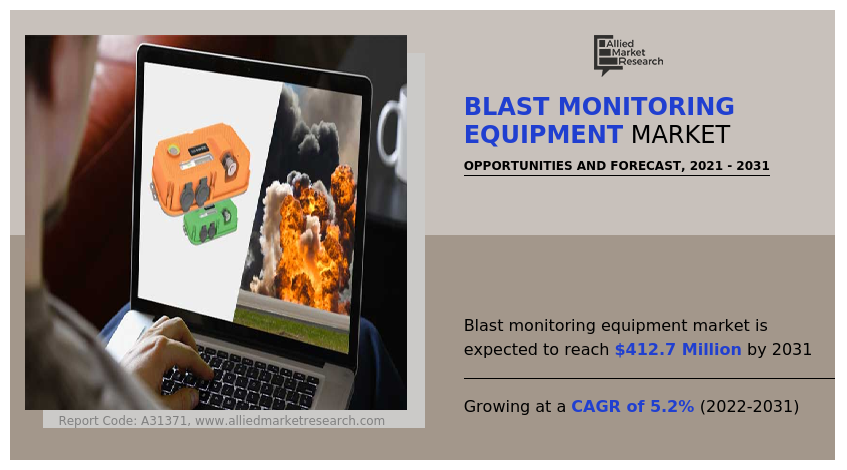
The effect of the governing rules of conduct and a lack of qualified technological resources for data processing further limit the market for blast monitoring equipment. Additionally, the lack of knowledge in vast distances, as well as blast monitoring equipment maintenance, are projected to hinder the blast monitoring equipment market during the forecast period.
The Industrial Internet of Things (IIoT) has opened new development potential for firms that require blast/vibration monitoring. Companies may link sensors used to monitor multiple machine factors, such as blast, vibration, and temperature, to the Internet and monitor their assets in real time by integrating IIoT with current production processes. Companies may use IIoT technology to combine and process all data on a single platform. Moreover, the use of IIoT for condition monitoring and predictive maintenance can significantly improve critical asset uptime, especially for assets with unpredictable failure patterns. Furthermore, IIoT allows companies to greatly increase their operational performance and dependability by implementing revolutionary changes in them through business process automation. In recent years, industries such as manufacturing and oil & gas have used IIoT in their operations. The increase in usage of IIoT represents a potential opportunity for the blast monitoring equipment market.
The key players profiled in the blast monitoring equipment market report include Orica, Acoem, ECOTECH PTY LTD, Hexagon AB, Core Lithium, and Maine Drilling and Blasting.
The blast monitoring equipment market is segmented on the basis of product type, end-use industry, application, and region. By product type, the market is divided into blast monitors, real time dust monitors, dust samplers, and visibility monitors. By end-use industry, the market is classified into defense, chemicals, mining & constriction, oil, appliances, and others. By application, the market is divided into underground mines, surface mining, demolition, rock blasting, and others. By region, the market is analyzed across North America, Europe, Asia-Pacific, and LAMEA.
The blast monitoring equipment industry is segmented into Product Type, End-use Industry and Application.
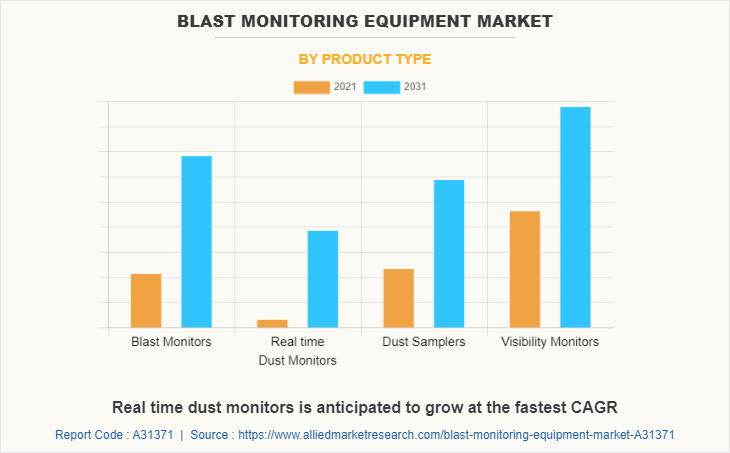
By product type, the blast monitors sub-segment is the second most dominating subsegment in 2021. Blast monitors have showcased improved blasting techniques in both underground and surface mining. The blast record contains a range of information used to assess the performance of a vibration. The blast recorders' charge which results in the highest vibration levels can be determined which is likely to be responsible for the greatest amount of breakage and damage. The effects of charge weight, charge length, and explosive strength can be measured. These are predicted to be the major factors affecting the blast monitoring equipment market size during the forecast period.
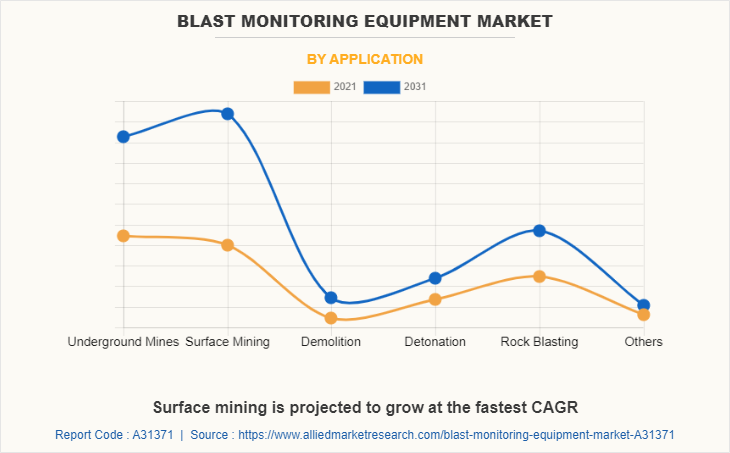
By application, the underground mines sub-segment dominated the market in 2021. Underground mines reduce expenditures and design time to ground control than surface mines and quarries because subsurface entrances are more challenging to develop and manage than rock or soil slopes. Workers are immediately exposed to the possibly unstable ground in the ore zone when using traditional underground mining methods such as shrinkage and cut-and-fill. Workers do not access the mineral zone when using bulk mining techniques such as blast hole stopping.
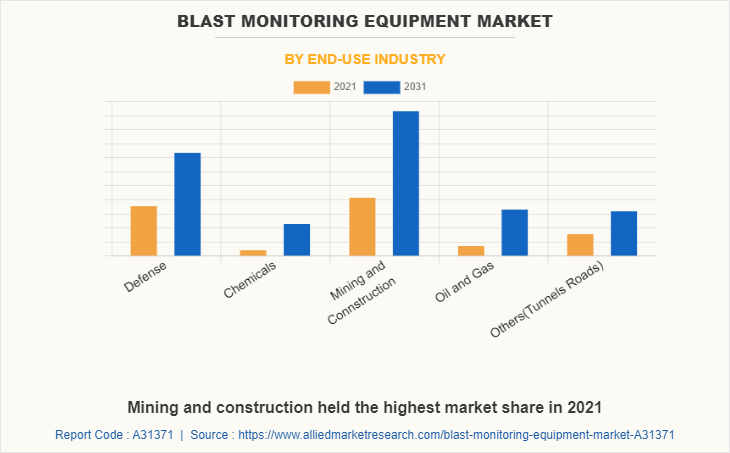
By end-use industry, the mining & construction sub-segment dominated the global blast monitoring equipment market share in 2021. The increase in construction and mining activities is essential for the advancement of civilization. Designing of equipment such as excavators, dozers, and cranes aid in the construction of better future infrastructure, such as skyscrapers, motorways, and sewers. Such applications of blast monitoring equipment in the mining and construction sector are bound to create a scope of growth for the sub-segment during the forecast period.
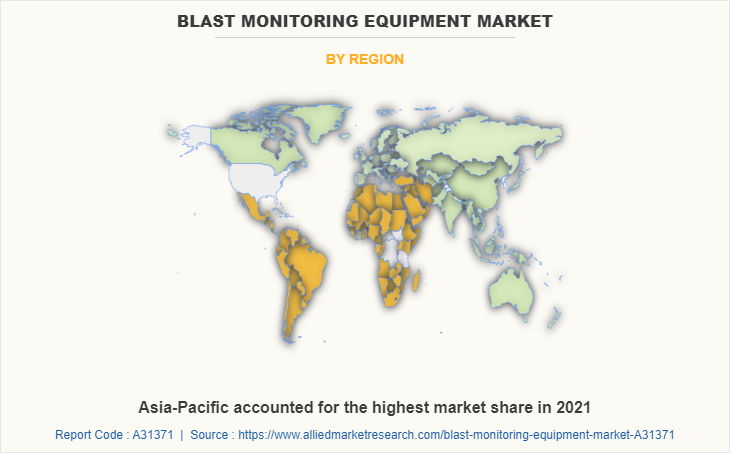
By region, Asia-Pacific dominated the global market in 2021 and is projected to be the fastest-growing region during the forecast period. The Asia-Pacific blast monitoring equipment market analysis is expanding as a consequence of the greater application of blast monitors throughout manufacturing activities in various industrial sectors and the strict regulations framework surrounding labor security in the rising mining industry. The Asia-Pacific market for blast monitoring equipment is expanding as a result of such factors as growing acceptance of predictive maintenance technology, competitive pressure to improve operational competence, expansion of manufacturing activities, and affordable labor costs in the Asia-Pacific developing region.
Impact of COVID-19 on the Global Blast Monitoring Equipment Industry
- COVID-19 has negatively impacted various industries such as construction, which has led to a drastic decline in construction sales. As blast monitoring is widely used in the construction industry, there was a significant reduction in blast monitoring equipment demand globally.
- China mining equipment market suffered greatly since day-to-day operations in mines were done with fewer personnel during the pandemic. However, sales of equipment dropped in the first several months of the pandemic. Sales returned to normal when the pandemic was brought under control. However, China being the epicenter of the coronavirus pandemic, export activities there were affected, leading to a decline in blast monitoring equipment production.
- Sales of blast monitoring equipment are directly proportional to the demand from end-use industries namely defense, chemicals, mining & construction, oil & gas, and others. However, the demand for blast monitoring equipment in the chemicals industry was greatly affected owing to import-export restrictions, closed borders, and supply chain disruptions due to the outbreak of the COVID-19 pandemic.
- The economic slowdown has affected the setup of new blast monitoring equipment projects across the world as the majority of government funding was diverted toward the healthcare sector owing to the rapid spread of the COVID-19 virus, impacting the market to the great extent
Key Benefits For Stakeholders
- This report provides a quantitative analysis of the market segments, current trends, estimations, and dynamics of the blast monitoring equipment market analysis from 2021 to 2031 to identify the prevailing blast monitoring equipment market opportunities.
- The market research is offered along with information related to key drivers, restraints, and opportunities.
- Porter's five forces analysis highlights the potency of buyers and suppliers to enable stakeholders make profit-oriented business decisions and strengthen their supplier-buyer network.
- In-depth analysis of the blast monitoring equipment market segmentation assists to determine the prevailing market opportunities.
- Major countries in each region are mapped according to their revenue contribution to the global market.
- Market player positioning facilitates benchmarking and provides a clear understanding of the present position of the market players.
- The report includes the analysis of the regional as well as global blast monitoring equipment market trends, key players, market segments, application areas, and market growth strategies.
Highlights of the Report
- The report provides an exclusive and comprehensive analysis of the global blast monitoring equipment market trends along with the blast monitoring equipment market forecast
- The report elucidates the blast monitoring equipment market opportunity along with key drivers, and restraints of the market. It is a compilation of detailed information, inputs from industry participants and industry experts across the value chain, and quantitative and qualitative assessment by industry analysts.
- Porter’s five forces analysis helps analyze the potential of the buyers & suppliers and the competitive scenario of the market for strategy building
- The report entailing the blast monitoring equipment market analysis maps the qualitative sway of various industry factors on market segments as well as geographies
- The data in this report aims on market dynamics, trends, and developments affecting the blast monitoring equipment market growth
- The report provide about the complete blast monitoring equipment market overview regarding the present and the forecasted period
Blast Monitoring Equipment Market Report Highlights
| Aspects | Details |
| Market Size By 2031 | USD 412.7 million |
| Growth Rate | CAGR of 5.2% |
| Forecast period | 2021 - 2031 |
| Report Pages | 318 |
| By Product Type |
|
| By End-use Industry |
|
| By Application |
|
| By Region |
|
| Key Market Players | ShotTrack Pty Ltd, acoem, Orica Ltd, GeoSonics/Vibra-Tech Inc., Finexplo Oy, Stanley Black & Decker, Inc., ids georadar, hexagon ab, sigicom ab, elcometer |
Analyst Review
An increase in demand for blast monitoring equipment in mining, excavations, and demolition sites is the key factor that is projected to drive the growth of the global blast monitoring equipment market during the forecast period. In addition, vibration monitoring is usually required near blasts in order to understand the outcome of the explosion by assessing the PPV - Peak Particle Velocity. However, technical expertise is required for system optimization, software upgrades, system networking, data transports, and other operations. Deploying blast monitoring technology in areas where blast information is scarce becomes difficult. Therefore, a lack of technical expertise is anticipated to restrict the overall market growth. The increase in usage of machine learning and big data analytics, as well as the advent of the Industrial Internet of Things (IIoT), are expected to provide lucrative opportunities for the industry, which will further drive the development rate of the blast monitoring equipment market in the future. Furthermore, strategic alliances and collaborations among different market competitors, as well as R&D initiatives for the integration of Artificial Intelligence (AI), are projected to provide multiple market growth opportunities.
Among the analyzed regions, Asia-Pacific is expected to account for the highest revenue in the market by 2031, followed by Europe, North America, and LAMEA. R&D initiatives for the integration of AI are the key factors responsible for the leading position of Asia-Pacific and Europe in the global blast monitoring equipment market.
The diverse applications of blast monitoring equipment across the chemical, construction, oil & gas, and other sectors are the major market drivers. In addition, the development of low-cost advanced blast monitoring equipment together with quick-processing features, easy blast technology, and better blast equipment is expected to provide significant market growth.
An increase in the application of blast monitoring equipment in the production of underground mines and in the mining, industry is anticipated to boost the blast monitoring equipment market in the upcoming years.
North America will provide more business opportunities for the global blast monitoring equipment market in the future.
The mining & construction sub-segment of the end-use industry acquired the maximum share of the global blast monitoring equipment market in 2021.
Acoem, ECOTECH PTY LTD, Hexagon AB, Core Lithium, Maine Drilling and Blasting, and Orica are the major players in the blast monitoring equipment market.
The major growth strategies adopted by the blast monitoring equipment market players are investments and manufacturing.
The report provides an extensive qualitative and quantitative analysis of the current trends and future estimations of the global blast monitoring equipment market from 2021 to 2031 to determine the prevailing opportunities.
The construction industry leaders and chemical manufacturers are the major customers in the global blast monitoring equipment market.
Loading Table Of Content...


